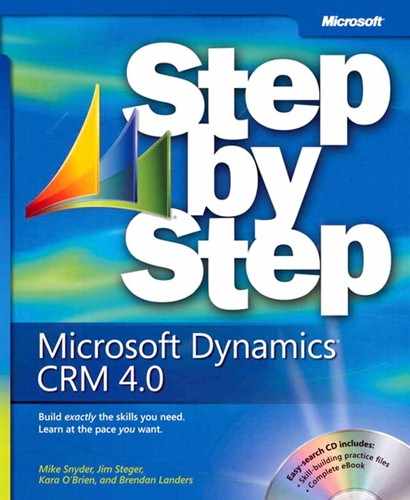As the previous exercises demonstrated, stepping through the Import Data Wizard is a straightforward process. The most time-consuming part of the process is creating a data map, which is a simple task that takes patience and an understanding of basic data concepts. To streamline the data import process, Microsoft Dynamics CRM allows you to create files that map automatically. This takes some set up using the Advanced Find tool, but you will find that it saves you valuable time in the long run.
See Also
For more information about Advanced Find, see Chapter 15.
Tip
The key to automatic mapping is the column headers in your import file. If the column headers in your import file match the field display names in Microsoft Dynamics CRM, your file will automatically map. You can create a template for your import file by using Advanced Find, so that the column headers mirror the field values in Microsoft Dynamics CRM, and then use Copy and Paste to paste the rows of data you would like to import into the template file.
In this exercise, you will create an Advanced Find query that you will export to create an import file that uses automatic mapping.
Note
USE your own Microsoft Dynamics CRM installation in place of the Adventure Works Cycle site shown in the exercise.
BE SURE TO use the Internet Explorer Web browser to navigate to your Microsoft Dynamics CRM Web site before beginning this exercise.
In the application menu bar, click Advanced Find.
The Advanced Find form opens.
In the Look For field, select Accounts.
In the Use Saved View field, select My Active Accounts.
Click Find in the lower-right corner of the Advanced Find query page.
The Results screen opens with the matching contact records.
On the Results screen, click the Export to Excel button.
The Export Data To Excel dialog box opens.
Select Static worksheet with records from this page, and then click Export.
The File Download screen opens.
Click Save, and save the file to a familiar location on your computer as MyAccounts.xls. Then close the Advanced Find screen.
Open the MyAccounts.xls file in Microsoft Office Excel, save it as a CSV file named MyAccounts.csv, and then close Excel.
Back in Microsoft Dynamics CRM, in the application menu bar, click Tools, and then click Import Data to launch the Import Data Wizard.
Click Browse, and locate the MyAccounts.csv file.
Leave the default Data delimiter and Field delimiter options, and click Next.
In the Record Type list, select Account.
The Data Map field is automatically populated with Automatic. This indicates that Microsoft Dynamics CRM has mapped your file for you.
Click Next on the Select Options page.
Click Import on the Confirm Import Details page.
Tip
Although it is unlikely that you will export a file from your Microsoft Dynamics CRM application and import it back into the system, you can easily use the output of the file as a template and paste import data into the file. Your file will automatically map as long as the column headings are not manipulated.

